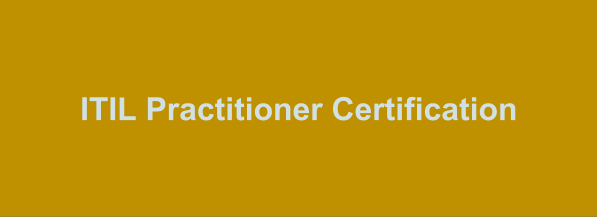Name: ITIL Practitioner Certification
ITIL Practitioner
The ITIL® Practitioner certification offers practical guidance on how to adopt and adapt the ITIL framework to support your business' objectives. It enables practitioners to not only speak the language of ITIL, but be able to translate it and use it in practice.
ITIL Practitioner can be taken at any stage in the ITIL certification scheme beyond Foundation. It provides a different set of skills not available in the existing certifications.
◈ ITIL Practitioner covers the Continual Service Improvement (CSI) approach as the way to structure any improvement initiatives.
◈ ITIL Practitioner also covers three key areas crucial for success of any improvement initiatives:
◈ Organizational Change Management
◈ Communication
◈ Measurement and Metrics.
The ITIL Practitioner content will also be reflected in ITIL 4, and its guiding principles will help IT professionals to adopt and adapt ITIL guidance to their own specific needs and circumstances. The guiding principles can (and should) be followed at every stage of service delivery.
ITIL Practitioner Exam Summary:
| Exam Name | ITIL Practitioner |
| Exam Code | ITIL Practitioner |
| Exam Fee | USD $150 |
| Exam Duration | 135 Minutes |
| Number of Questions | 40 |
| Passing Score | 70% |
| Format | Multiple Choice |
| Sample Questions | ITIL Practitioner Exam Sample Questions and Answers |
| Practice Exam | ITIL Practitioner Practice Test |
ITIL Practitioner Syllabus Topics:
| Unit | Content |
| 1 | - Apply the concept of ‘adopt and adapt’ when using ITIL guidance in a given context - Analyze the importance of each element of a service when planning and implementing service improvements |
| 2 | - Apply the ITSM guiding principles in a given context when planning and implementing service improvements |
| 3 | - Describe the purpose and main outputs of each step of the CSI Approach - Use the CSI Approach tools and techniques successfully in a given specific context - Apply the CSI approach to a given context, demonstrating an understanding of the critical competences, the guiding principles and the scientific method |
| 4 | - Define critical success factors (CSFs) using a relevant hierarchical approach - Determine key performance indicators (KPIs) to underpin a critical success factor - Analyze CSFs and KPIs in a given context to ensure that they are balanced between the four categories - Define a current state assessment in a given context - Design a report in a given context - Apply knowledge of metrics and measurement when planning and implementing improvements, particularly in the context of the CSI approach and/or the guiding principles |
| 5 | - Explain the nature, value, importance and benefits of good communication - Explain communication principles - Explain the purpose and value of communication tools and techniques - Use relevant communication tools and techniques to support improvement in a given context - Apply knowledge of communications when planning and implementing improvements, particularly in the context of the CSI approach and/or the guiding principles |
| 6 | - Explain the role and impact of OCM in successful improvement - Describe the purpose and value of OCM activities - Use relevant OCM tools and techniques to support improvement in a given context - Apply knowledge of OCM when planning and implementing improvements, particularly in the context of the CSI approach and/or the guiding principles |





0 comments:
Post a Comment